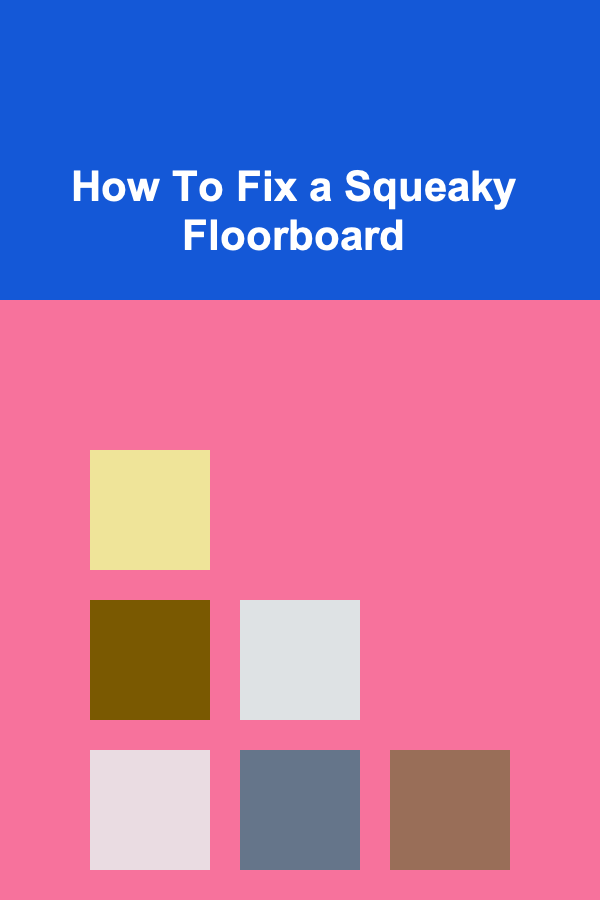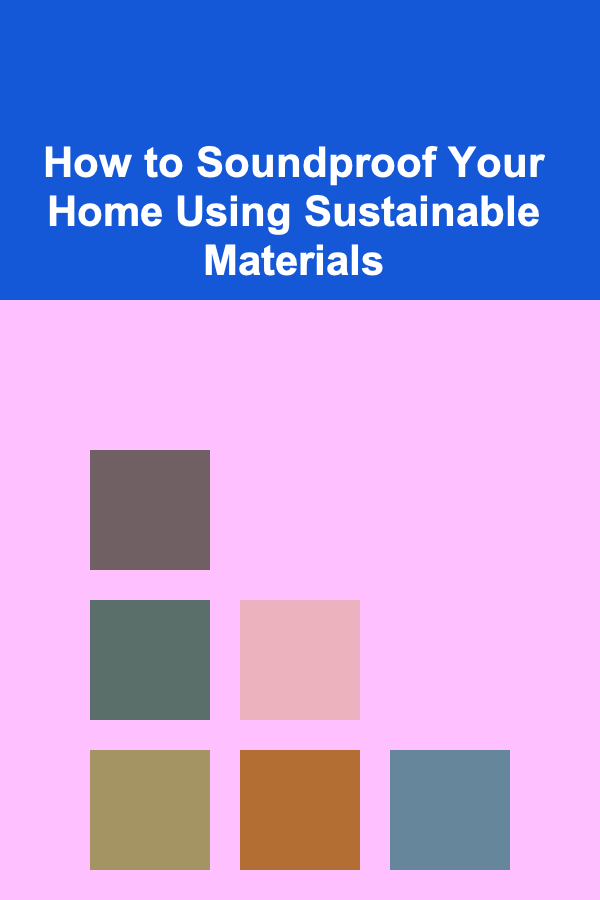
How To Fix a Squeaky Floorboard
ebook include PDF & Audio bundle (Micro Guide)
$12.99$7.99
Limited Time Offer! Order within the next:

Squeaky floorboards are one of those frustrating household problems that can disrupt the peaceful atmosphere of your home. Whether it's the annoying creak in the middle of the night that wakes you up or the constant noise when walking across the floor, squeaky floorboards can be a persistent nuisance. But fear not---there are several methods to fix squeaky floorboards effectively, and you don't need to be an expert handyman to do so.
In this guide, we'll explore why floorboards squeak, the common causes behind the noise, and how to fix them using both simple and more advanced techniques. We'll also dive into preventative measures you can take to avoid future squeaks. So, let's get started and learn how to silence those squeaky floorboards once and for all!
Why Do Floorboards Squeak?
Before diving into the solutions, it's essential to understand why floorboards squeak in the first place. Several factors contribute to this common problem, including:
1. Loose Floorboards
One of the most common causes of squeaky floors is loose boards. Over time, the nails or screws holding the boards in place can become loose, allowing the boards to move slightly when pressure is applied, causing a squeak.
2. Wood Shrinkage
Wood is a natural material that reacts to changes in temperature and humidity. When the wood expands and contracts with changes in climate, it can lead to gaps between the floorboards and the subfloor beneath, causing friction and squeaks.
3. Worn-out Screws or Nails
Floorboards are typically secured with nails or screws, and as these fasteners age, they can become loose or worn out. When the nails or screws no longer grip the wood firmly, the boards shift when weight is applied, producing the familiar squeak.
4. Subfloor Movement
The subfloor, the layer beneath the visible flooring, plays a crucial role in the integrity of your floor. If the subfloor moves or shifts, it can cause the floorboards to become uneven or loose, resulting in squeaky floors.
5. Structural Issues
In some cases, squeaky floorboards can be a sign of more significant structural issues in your home. Foundation problems or settling of the building can cause floors to shift and become misaligned, leading to squeaks.
6. Insufficient Floorboard Support
In older homes, floorboards may not have the proper support structure beneath them. Insufficient joists or spacing can cause the boards to flex and move, producing squeaks when walked on.
How to Fix a Squeaky Floorboard
Now that we understand why floorboards squeak, let's look at various methods for fixing them. There are simple DIY fixes, as well as more involved solutions if the problem is more severe. We'll begin with the easiest and least intrusive methods before moving on to more advanced techniques.
1. Screw Down Loose Floorboards
The most common fix for squeaky floorboards is to secure loose boards with screws. Over time, nails may come loose, and the boards can move when walked on, causing friction that leads to squeaks. Replacing nails with screws is a simple and effective solution.
Tools and Materials:
- Drill with screwdriver bit
- Screws (preferably wood screws)
- Wood filler (optional)
- Hammer
- Small screwdriver (if necessary)
Steps:
- Locate the Squeak: Identify which floorboard is causing the squeak. You can often pinpoint the location by walking on the floor and listening carefully for the sound. If the squeak is widespread, you may need to check several floorboards.
- Screw the Floorboard: Using a drill, drive screws into the floorboard where the nails have loosened. Be sure to drill into the joists beneath the floor to ensure a secure hold. For extra security, you can use screws that are long enough to go through the floorboard and into the subfloor beneath.
- Countersink the Screws: If the screw heads are visible, you can countersink them using a drill with a countersink bit. This will allow the screw to sit below the surface of the floorboard, so it's not noticeable.
- Fill in the Holes: If you used wood screws and the holes are visible, fill them with wood filler to create a smooth finish. Once the filler dries, sand it down until it's flush with the rest of the floor.
- Test for Squeaks: After screwing down the loose boards and filling any holes, walk over the area again to see if the squeak is gone. If the squeak persists, try adding additional screws to other spots on the floorboard.
2. Use Squeak-Repair Kits
Another simple solution is to use a squeak-repair kit. These kits typically include screws or brackets designed to be installed from below the floor (if you have access to a basement or crawl space). The repair kit may also come with instructions for identifying and fixing squeaky areas without needing to remove any flooring.
Steps:
- Access the Subfloor: If possible, gain access to the area beneath the floorboard. This can usually be done through a crawl space or basement.
- Install the Repair Kit: Follow the instructions provided with the kit. Typically, you will insert the screws into the joists under the squeaky area. These screws will secure the floorboards to the joists and reduce the movement that causes squeaks.
- Test the Floor: After installation, test the floor to ensure that the squeaks have been eliminated.
3. Lubricate the Floorboard
In some cases, the squeak may be caused by friction between the floorboards or between the floorboards and the subfloor. You can try lubricating the area with a dry lubricant or talcum powder to reduce friction and stop the squeak.
Tools and Materials:
- Talcum powder or baby powder
- Paintbrush or broom
Steps:
- Locate the Squeak: Identify the squeaky spot and check for any visible gaps or areas where the floorboard is rubbing against the subfloor.
- Apply Talcum Powder: Sprinkle talcum powder or baby powder into the gap between the floorboard and the subfloor. Use a paintbrush or broom to spread the powder evenly.
- Test the Floor: Walk on the floor to check if the squeak has stopped. The powder acts as a dry lubricant, reducing friction and eliminating the noise.
4. Replace Damaged Floorboards
If a floorboard is severely warped or damaged, it may need to be replaced entirely. This is a more involved solution but may be necessary if the squeak persists despite other efforts.
Tools and Materials:
- Replacement floorboard
- Saw
- Wood glue
- Nails or screws
Steps:
- Remove the Damaged Floorboard: Use a saw to cut the damaged floorboard along the edges. Carefully remove it, making sure not to damage the surrounding boards.
- Prepare the Replacement Board: Measure and cut a replacement floorboard to fit the space. Apply wood glue along the edges to ensure a secure fit.
- Install the New Floorboard: Place the replacement board in position and secure it with nails or screws. Ensure it is properly aligned with the surrounding boards.
- Finish the Floor: If necessary, sand down the edges of the new board to create a smooth transition between the old and new sections of the floor.
5. Add More Support to the Subfloor
If your floor squeaks because of movement in the subfloor, it may be necessary to add more support. This can involve installing additional joists or reinforcing the existing ones to prevent movement.
Steps:
- Access the Subfloor: If you have access to the area beneath the floor (via a basement or crawl space), inspect the subfloor for any signs of movement or weakness.
- Install Additional Joists: If needed, add additional joists to provide more support for the floorboards above. This can be done by securing new joists to the existing framework.
- Reinforce Existing Joists: If the existing joists are weak, you may need to reinforce them with additional lumber or metal brackets.
- Test for Squeaks: After reinforcing the subfloor, walk over the floor to check if the squeaks have been eliminated.
Preventing Future Squeaks
Once you've fixed your squeaky floorboards, it's essential to take steps to prevent the problem from recurring. Here are some tips to help you keep your floorboards squeak-free:
- Maintain Proper Humidity: Keep the humidity levels in your home stable to prevent wood from expanding and contracting. Use a humidifier in the winter to add moisture to the air and prevent wood from shrinking.
- Use Carpet or Rugs: Placing rugs or carpets over squeaky areas can help reduce the noise by providing an extra layer of cushion between the floor and foot traffic.
- Regular Maintenance: Periodically check the condition of your floorboards and fasteners to ensure they remain secure. Tighten any loose screws or nails to prevent future squeaks.
Conclusion
Squeaky floorboards can be an irritating issue, but with the right tools and techniques, it's a problem that you can solve yourself. Whether you choose to screw down loose boards, use a squeak-repair kit, lubricate the floor, or replace damaged boards, the key is to identify the root cause of the squeak and address it accordingly.
By following these steps and taking preventative measures, you can enjoy a quiet, peaceful floor free of squeaks. Don't let that annoying creak ruin your day---take action today to fix it!

How to Keep Your Pet's Coat Healthy and Shiny
Read More
How to Organize Your Car for Quick Errands
Read More
How to Soundproof Your Home Using Sustainable Materials
Read More
How To Write Clear and Concise Remote Communications
Read More
How to Track Pet Care Expenses for Budgeting Success
Read More
10 Tips for Protecting Your Hearing at Concerts
Read MoreOther Products

How to Keep Your Pet's Coat Healthy and Shiny
Read More
How to Organize Your Car for Quick Errands
Read More
How to Soundproof Your Home Using Sustainable Materials
Read More
How To Write Clear and Concise Remote Communications
Read More
How to Track Pet Care Expenses for Budgeting Success
Read More